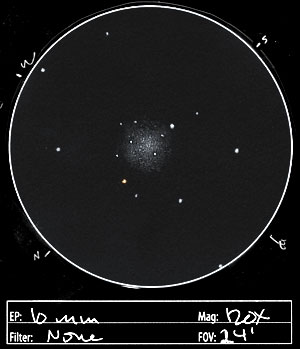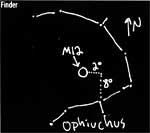
Observation Notes:
 This is a big, mottled globular cluster. Averted vision gave it an overall grainy appearance with brighter stars flickering in and out across the surface. The central condensation was there, but not it was not strong. It seemed to form a trianugalr shape with one apex pointing northeast. An orange star sat just to the north. The extent seemed to be about 4′ across.
This is a big, mottled globular cluster. Averted vision gave it an overall grainy appearance with brighter stars flickering in and out across the surface. The central condensation was there, but not it was not strong. It seemed to form a trianugalr shape with one apex pointing northeast. An orange star sat just to the north. The extent seemed to be about 4′ across.
Factoids:
M12 is very similar to its nearby neighbor, M10, but is slightly larger and fainter. It is not very concentrated and was once thought to be an intermediate between globular and open clusters. It lies 16,000 light years away, with a diameter of about 75 light years, and is approaching us at 16 km/sec.
M12 was discovered by Charles Messier in 1764, and first resolved into stars by William Herschel in 1783.
| Subject | M12 (NGC 6218) |
| Classification | Globular Cluster (Class IX) |
| Position* | Ophiuchus [RA: 16:47:12 / Dec: -01:57:00] |
| Size* | 16.0′ |
| Brightness* | 6.7 |
| Date/Time | September 25, 2005 – 8:45 PM (September 26, 2005 – 03:45 UT) |
| Observing Loc. | Flagstaff, AZ – Home |
| Instrument | Orion SVP 6LT Reflector (150 mm dia./1200 mm F/L) |
| Eyepieces/Mag. | 10 mm (120X) |
| Conditions | Clear, mostly calm, 62°F |
| Seeing | ~3-4/10 |
| Transparency | Mag 4.6 NELM (based on 20-Ophi) |
| Sources | SEDS |
*Based on published data.